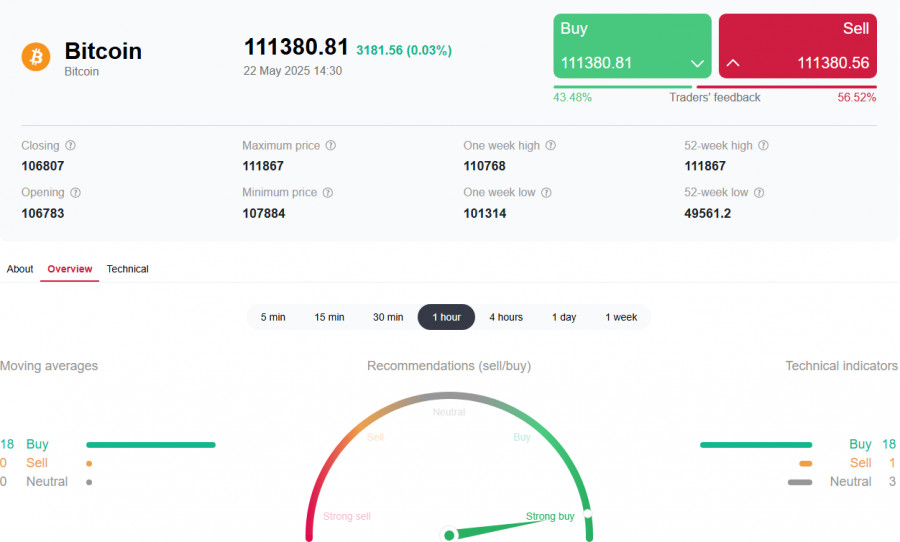

analytics1_1

Bitcoin aims to hit $120,000? What lies behind its rally and when to expect retracement
Bitcoin aims to hit $120,000? What lies behind its rally and when to expect retracement

Crypto-currencies
2025-05-22 14:12:21
On May 22, Bitcoin confidently broke through the $111,888 level, setting a new all-time high of $111,867. Unlike previous rallies marked by retail investor euphoria, this time the market's behavior is different.
Participants are increasingly speaking not of speculative frenzy, but of a fundamental shift in how Bitcoin is perceived in the financial world. It's no longer just a rising asset — it's becoming a contender for a systemic role in the global economy.
Institutional investors drive the current rally
Options exchanges, ETFs, public companies, and even state banks are all funneling capital into Bitcoin in sync. What's behind this trend, and what are its limits?
Options market: a mirror of Wall Street's expectations

A massive surge of interest has been recorded on Deribit, the options market: open interest in BTC options has reached a record $42.5 billion. Deribit CEO Luuk Strijers openly stated that this is the result of "serious money" flowing in from major players betting on continued growth.
The most actively traded contracts are for $110K, $120K, and even $300K strikes expiring at the end of June. In other words, the pros are not just believing in the current trend — they are betting it will last through mid-summer.
This isn't thin market speculation; the situation on Deribit reflects real confidence in Bitcoin's future from players voting with billions of dollars.
ETFs: a financial revolution in action
More important than investor sentiment is the infrastructure channeling capital into crypto — and nothing exemplifies this better than spot Bitcoin ETFs. On May 21 alone, US Bitcoin ETFs saw net inflows of $607 million, $530 million of which went to BlackRock's iShares Bitcoin Trust. Over the past 11 days: $2.7 billion. Year-to-date: over $42 billion.
ETF Store and Bloomberg report that 26 of the past 27 trading days saw net positive inflows. Not even gold ETFs saw such momentum during their boom years. The market isn't just reacting — it's being reshaped.
BlackRock's IBIT now holds 636,120 BTC — more than all its competitors combined. Its investors include hedge funds, pension funds, sovereign wealth funds (like Mubadala), and corporations. A new dimension is emerging: Bitcoin is no longer just an asset — it's becoming a core component of institutional portfolios with direct access through familiar structures.
Corporations join the game: balance sheets shine with digital gold
Public companies are increasingly getting involved too. Strategy and Metaplanet have already invested nearly $1 billion. Twenty One Capital is going public through a deal with Cantor Fitzgerald and holds 42,000 BTC on its balance sheet. Strive Asset Management and Asset Entities are creating the first public entity managed through Bitcoin reserves with an investment horizon of up to $1 billion.
Even state-owned banks (like France's Bpifrance) and companies from India, Brazil, and Indonesia are participating. Their motivation is clear: asset protection, value growth, and independence from inflation-prone national currencies.
Macroeconomics: a storm that fills Bitcoin's sails
Traditional markets are adding fuel to Bitcoin's fire. Yields on 30-year Japanese bonds are breaking records at 3.14%, yet demand is vanishing. Japanese investors — traditionally large holders of US debt — may soon begin large-scale selling, putting pressure on Treasuries and deepening dollar liquidity issues.
At the same time, the US dollar index is falling, and CFTC data show record short positions against it. This is fundamental: investors are fleeing from dollars into real assets. Meanwhile, global M2 money supply across the US, EU, China, and Japan has been growing for the second straight quarter. Historically, this correlates with Bitcoin's rally with a lag of 2–3 months.
Bitcoin is increasingly viewed as a new safe-haven asset. In a world where bonds no longer provide yield and the dollar lacks resilience, this limited-supply cryptocurrency is emerging as the new "digital goldmine."
Retail investors missing out? Good omen!
Santiment reports that despite the rally, Bitcoin-related social activity remains at "bear market" levels. Search queries and social media discussions are minimal. Paradoxically, this often accompanies sustained uptrends — speculators are on the sidelines while major players quietly accumulate.
Binance data backs this up. According to CryptoQuant, the spot-to-futures ratio has dropped to 4.9 — the lowest in 18 months. This indicates traders are more focused on leveraged short-term speculation than long-term holding. While this may boost volatility, it doesn't shake the fundamentals.
Profits without profit-taking: the market is holding steady
Another key signal: unrealized profit/loss data shows that profits are widely distributed, but no one is rushing to cash out. This is a strong sign of market stability — sharp corrections often follow mass profit-taking by short-term players, which is not happening now.
Short-term outlook (through end of June):
High probability of reaching $120,000, especially given continued ETF inflows and lack of correction selling.
Increased volatility is likely due to futures dominance. Pullbacks to $105,000–107,000 are possible, but not critical.
Long-term outlook (through end of 2025):
If current institutional accumulation and global M2 growth persist, the $150,000–180,000 range appears realistic.
Main risks: aggressive ETF regulation, political decisions by the Federal Reserve, and potential liquidity crises.
Смотрите также


